Business Report: Analysis of Negotiation Approaches and Strategies
VerifiedAdded on 2022/10/10
|13
|2852
|68
Report
AI Summary
This business report analyzes different negotiation approaches, focusing on win-win and win-lose strategies. It defines negotiation in the workplace, emphasizing its importance in conflict resolution and daily management tasks. The report outlines the objectives, methodologies (secondary data collection), and characteristics of each approach, including their assumptions and associated risks. It explores the impact of each approach on relationships and provides recommendations for fair processes, joint problem-solving, and transparency. The report also includes an introduction, objectives, methodologies, information analysis, findings, recommendations, and references, providing a comprehensive overview of negotiation strategies and their practical applications. The report aims to help managers understand and effectively utilize various negotiation techniques for successful outcomes in workplace conflicts and agreements.
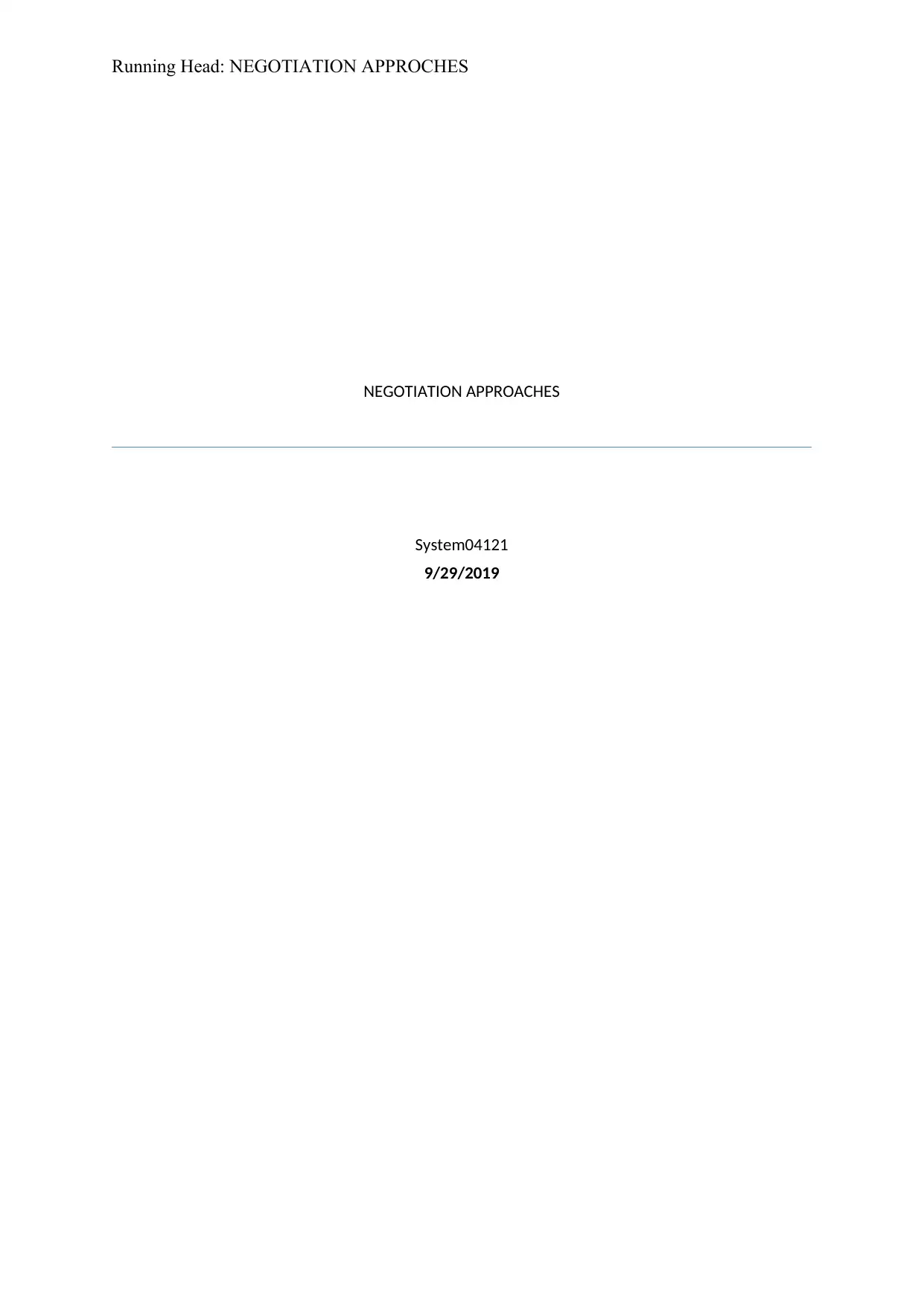
Running Head: NEGOTIATION APPROCHES
NEGOTIATION APPROACHES
System04121
9/29/2019
NEGOTIATION APPROACHES
System04121
9/29/2019
Paraphrase This Document
Need a fresh take? Get an instant paraphrase of this document with our AI Paraphraser
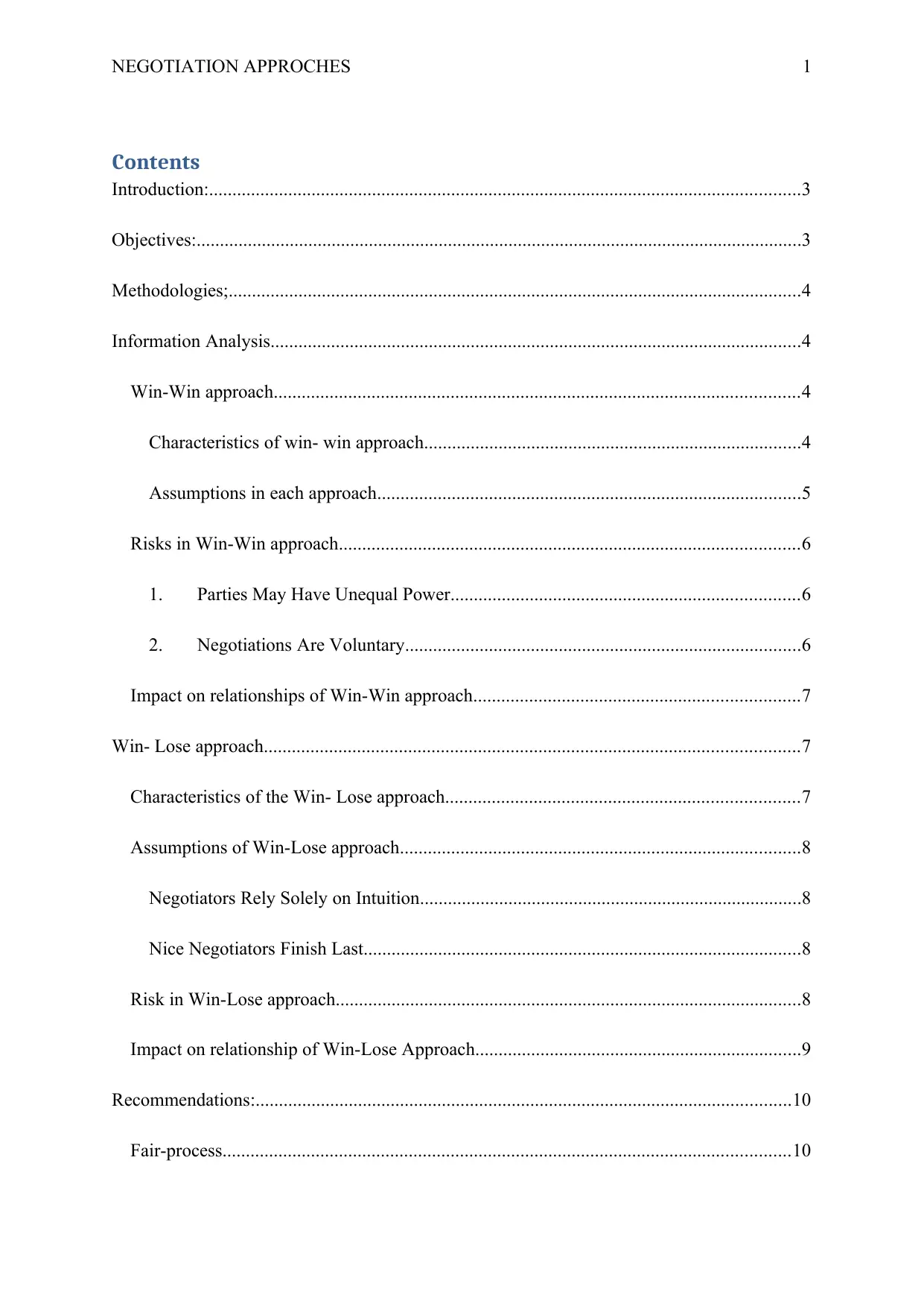
NEGOTIATION APPROCHES 1
Contents
Introduction:...............................................................................................................................3
Objectives:..................................................................................................................................3
Methodologies;...........................................................................................................................4
Information Analysis..................................................................................................................4
Win-Win approach.................................................................................................................4
Characteristics of win- win approach.................................................................................4
Assumptions in each approach...........................................................................................5
Risks in Win-Win approach...................................................................................................6
1. Parties May Have Unequal Power...........................................................................6
2. Negotiations Are Voluntary.....................................................................................6
Impact on relationships of Win-Win approach......................................................................7
Win- Lose approach...................................................................................................................7
Characteristics of the Win- Lose approach............................................................................7
Assumptions of Win-Lose approach......................................................................................8
Negotiators Rely Solely on Intuition..................................................................................8
Nice Negotiators Finish Last..............................................................................................8
Risk in Win-Lose approach....................................................................................................8
Impact on relationship of Win-Lose Approach......................................................................9
Recommendations:...................................................................................................................10
Fair-process..........................................................................................................................10
Contents
Introduction:...............................................................................................................................3
Objectives:..................................................................................................................................3
Methodologies;...........................................................................................................................4
Information Analysis..................................................................................................................4
Win-Win approach.................................................................................................................4
Characteristics of win- win approach.................................................................................4
Assumptions in each approach...........................................................................................5
Risks in Win-Win approach...................................................................................................6
1. Parties May Have Unequal Power...........................................................................6
2. Negotiations Are Voluntary.....................................................................................6
Impact on relationships of Win-Win approach......................................................................7
Win- Lose approach...................................................................................................................7
Characteristics of the Win- Lose approach............................................................................7
Assumptions of Win-Lose approach......................................................................................8
Negotiators Rely Solely on Intuition..................................................................................8
Nice Negotiators Finish Last..............................................................................................8
Risk in Win-Lose approach....................................................................................................8
Impact on relationship of Win-Lose Approach......................................................................9
Recommendations:...................................................................................................................10
Fair-process..........................................................................................................................10

NEGOTIATION APPROCHES 2
Joint problem-solving...........................................................................................................10
Transparency and trust.........................................................................................................10
References................................................................................................................................12
Joint problem-solving...........................................................................................................10
Transparency and trust.........................................................................................................10
References................................................................................................................................12
⊘ This is a preview!⊘
Do you want full access?
Subscribe today to unlock all pages.

Trusted by 1+ million students worldwide
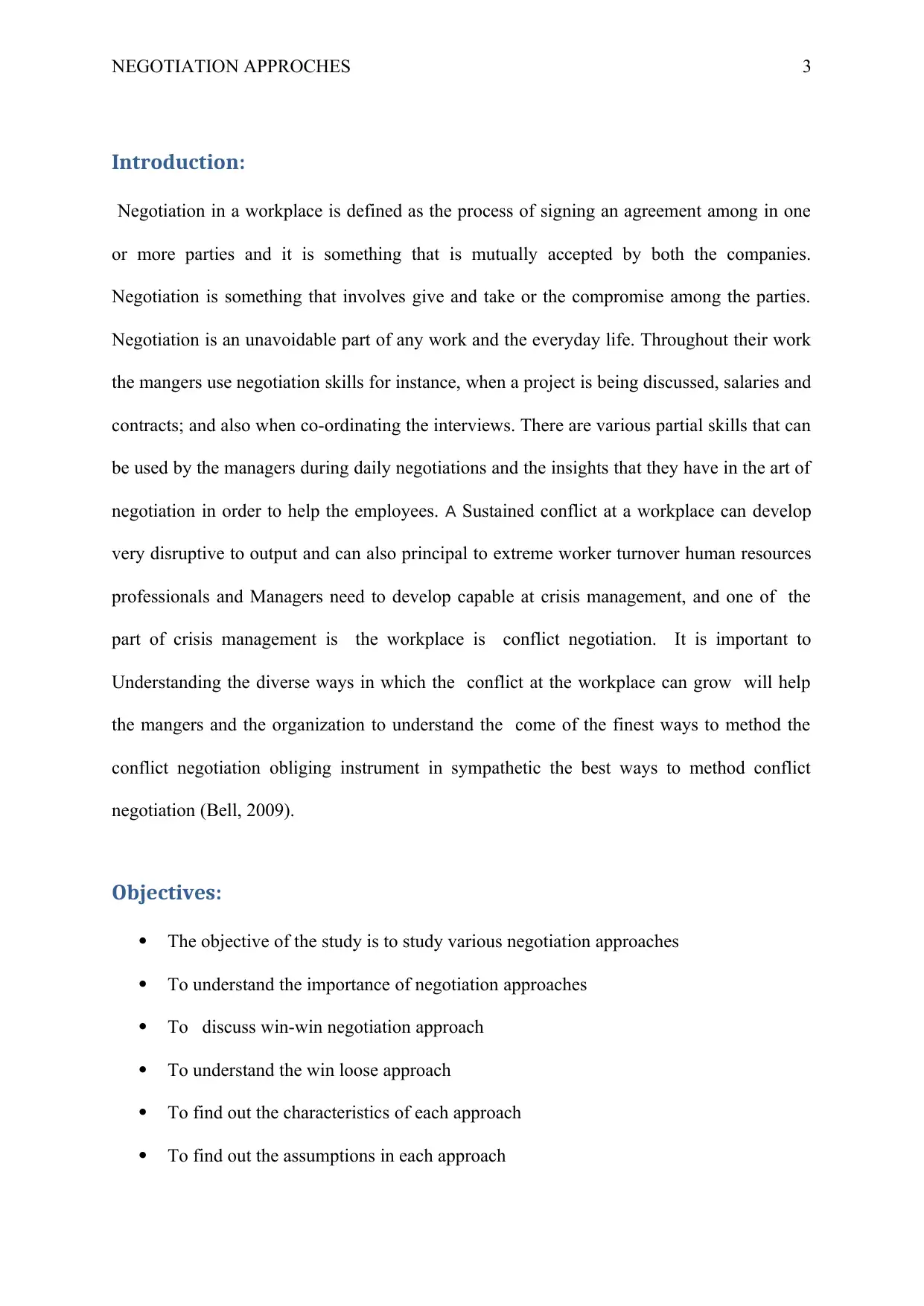
NEGOTIATION APPROCHES 3
Introduction:
Negotiation in a workplace is defined as the process of signing an agreement among in one
or more parties and it is something that is mutually accepted by both the companies.
Negotiation is something that involves give and take or the compromise among the parties.
Negotiation is an unavoidable part of any work and the everyday life. Throughout their work
the mangers use negotiation skills for instance, when a project is being discussed, salaries and
contracts; and also when co-ordinating the interviews. There are various partial skills that can
be used by the managers during daily negotiations and the insights that they have in the art of
negotiation in order to help the employees. A Sustained conflict at a workplace can develop
very disruptive to output and can also principal to extreme worker turnover human resources
professionals and Managers need to develop capable at crisis management, and one of the
part of crisis management is the workplace is conflict negotiation. It is important to
Understanding the diverse ways in which the conflict at the workplace can grow will help
the mangers and the organization to understand the come of the finest ways to method the
conflict negotiation obliging instrument in sympathetic the best ways to method conflict
negotiation (Bell, 2009).
Objectives:
The objective of the study is to study various negotiation approaches
To understand the importance of negotiation approaches
To discuss win-win negotiation approach
To understand the win loose approach
To find out the characteristics of each approach
To find out the assumptions in each approach
Introduction:
Negotiation in a workplace is defined as the process of signing an agreement among in one
or more parties and it is something that is mutually accepted by both the companies.
Negotiation is something that involves give and take or the compromise among the parties.
Negotiation is an unavoidable part of any work and the everyday life. Throughout their work
the mangers use negotiation skills for instance, when a project is being discussed, salaries and
contracts; and also when co-ordinating the interviews. There are various partial skills that can
be used by the managers during daily negotiations and the insights that they have in the art of
negotiation in order to help the employees. A Sustained conflict at a workplace can develop
very disruptive to output and can also principal to extreme worker turnover human resources
professionals and Managers need to develop capable at crisis management, and one of the
part of crisis management is the workplace is conflict negotiation. It is important to
Understanding the diverse ways in which the conflict at the workplace can grow will help
the mangers and the organization to understand the come of the finest ways to method the
conflict negotiation obliging instrument in sympathetic the best ways to method conflict
negotiation (Bell, 2009).
Objectives:
The objective of the study is to study various negotiation approaches
To understand the importance of negotiation approaches
To discuss win-win negotiation approach
To understand the win loose approach
To find out the characteristics of each approach
To find out the assumptions in each approach
Paraphrase This Document
Need a fresh take? Get an instant paraphrase of this document with our AI Paraphraser

NEGOTIATION APPROCHES 4
To understand the risks in each approach, and
To understand the probable impact on relationships of each approach
Methodologies;
Data collection is tool or a technique which is also a way to collect and access the facts and
figures related to the research. There are numerous kinds of methods for research which can
be helpful in collecting the facts and figures and those methods are secondary and primary
way of collecting the data. In the following report the method used for gathering the
relevancy of negotiation approaches is secondary method. The secondary method gathers the
information from various different sources like internal and external sources which includes
journals, books, articles and the websites (Foster, 2009)
Information Analysis
Win-Win approach
A win-win negotiation is a kind of settlement which is also in an integrative negotiated
agreement. In form of theory it simply means that both the parties involved in the negotiation
process have reached to a mutual agreement and it cannot be changed or improved upon
further by any of the other agreement.
Characteristics of win- win approach
It is a kind of negotiation that is fair and well balances in which all the parties are involved in
a deal benefit in the long term. It is not a negotiation that is based on one party’s win and the
other party loosing instead it includes both the parties the characteristic of this Win –Win
negotiation skill is that it helps in preparing and planning skills. Knowledge of the subject
and matter that is being negotiated, it includes the ability to think in a clear and a rapid
To understand the risks in each approach, and
To understand the probable impact on relationships of each approach
Methodologies;
Data collection is tool or a technique which is also a way to collect and access the facts and
figures related to the research. There are numerous kinds of methods for research which can
be helpful in collecting the facts and figures and those methods are secondary and primary
way of collecting the data. In the following report the method used for gathering the
relevancy of negotiation approaches is secondary method. The secondary method gathers the
information from various different sources like internal and external sources which includes
journals, books, articles and the websites (Foster, 2009)
Information Analysis
Win-Win approach
A win-win negotiation is a kind of settlement which is also in an integrative negotiated
agreement. In form of theory it simply means that both the parties involved in the negotiation
process have reached to a mutual agreement and it cannot be changed or improved upon
further by any of the other agreement.
Characteristics of win- win approach
It is a kind of negotiation that is fair and well balances in which all the parties are involved in
a deal benefit in the long term. It is not a negotiation that is based on one party’s win and the
other party loosing instead it includes both the parties the characteristic of this Win –Win
negotiation skill is that it helps in preparing and planning skills. Knowledge of the subject
and matter that is being negotiated, it includes the ability to think in a clear and a rapid
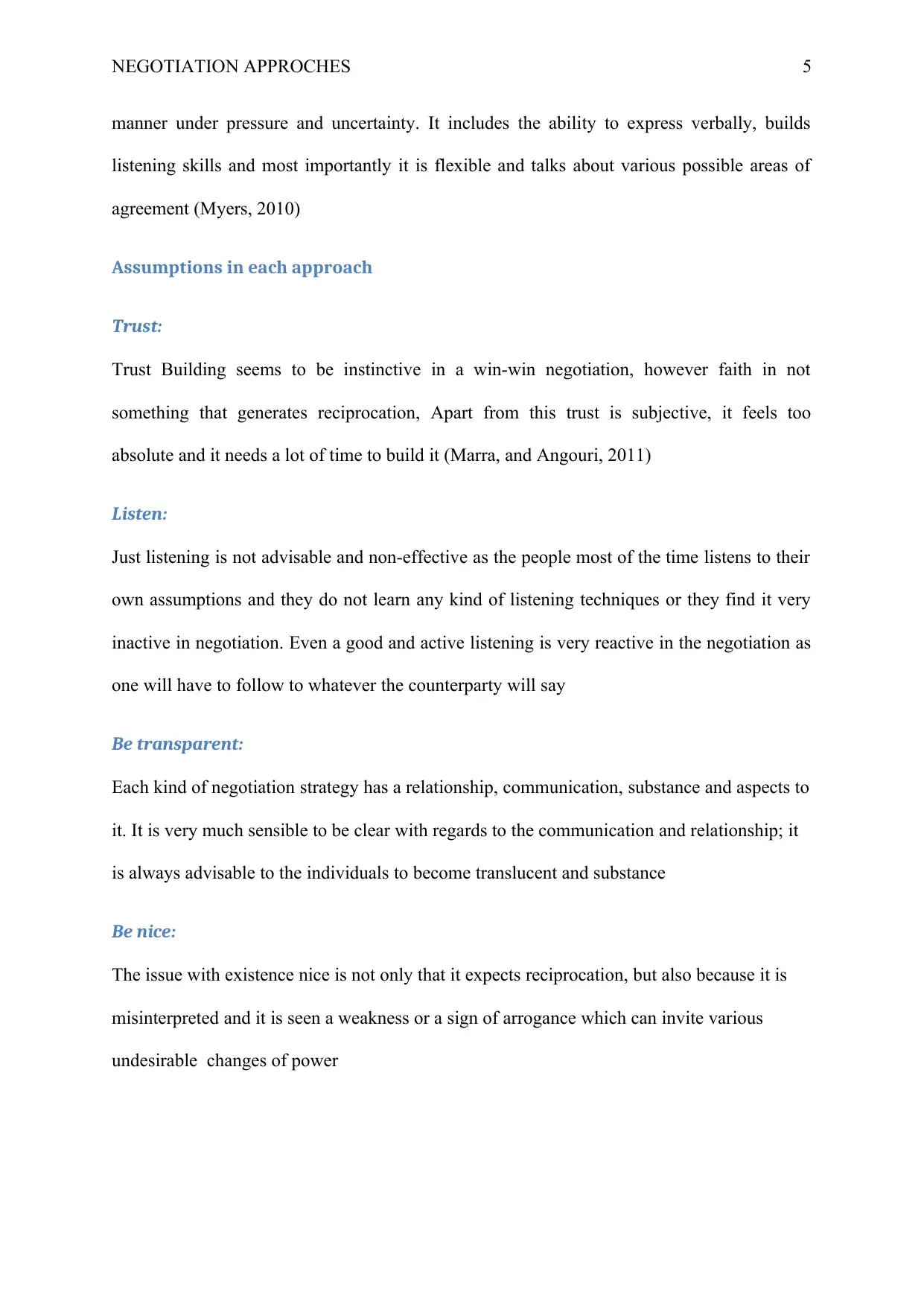
NEGOTIATION APPROCHES 5
manner under pressure and uncertainty. It includes the ability to express verbally, builds
listening skills and most importantly it is flexible and talks about various possible areas of
agreement (Myers, 2010)
Assumptions in each approach
Trust:
Trust Building seems to be instinctive in a win-win negotiation, however faith in not
something that generates reciprocation, Apart from this trust is subjective, it feels too
absolute and it needs a lot of time to build it (Marra, and Angouri, 2011)
Listen:
Just listening is not advisable and non-effective as the people most of the time listens to their
own assumptions and they do not learn any kind of listening techniques or they find it very
inactive in negotiation. Even a good and active listening is very reactive in the negotiation as
one will have to follow to whatever the counterparty will say
Be transparent:
Each kind of negotiation strategy has a relationship, communication, substance and aspects to
it. It is very much sensible to be clear with regards to the communication and relationship; it
is always advisable to the individuals to become translucent and substance
Be nice:
The issue with existence nice is not only that it expects reciprocation, but also because it is
misinterpreted and it is seen a weakness or a sign of arrogance which can invite various
undesirable changes of power
manner under pressure and uncertainty. It includes the ability to express verbally, builds
listening skills and most importantly it is flexible and talks about various possible areas of
agreement (Myers, 2010)
Assumptions in each approach
Trust:
Trust Building seems to be instinctive in a win-win negotiation, however faith in not
something that generates reciprocation, Apart from this trust is subjective, it feels too
absolute and it needs a lot of time to build it (Marra, and Angouri, 2011)
Listen:
Just listening is not advisable and non-effective as the people most of the time listens to their
own assumptions and they do not learn any kind of listening techniques or they find it very
inactive in negotiation. Even a good and active listening is very reactive in the negotiation as
one will have to follow to whatever the counterparty will say
Be transparent:
Each kind of negotiation strategy has a relationship, communication, substance and aspects to
it. It is very much sensible to be clear with regards to the communication and relationship; it
is always advisable to the individuals to become translucent and substance
Be nice:
The issue with existence nice is not only that it expects reciprocation, but also because it is
misinterpreted and it is seen a weakness or a sign of arrogance which can invite various
undesirable changes of power
⊘ This is a preview!⊘
Do you want full access?
Subscribe today to unlock all pages.

Trusted by 1+ million students worldwide
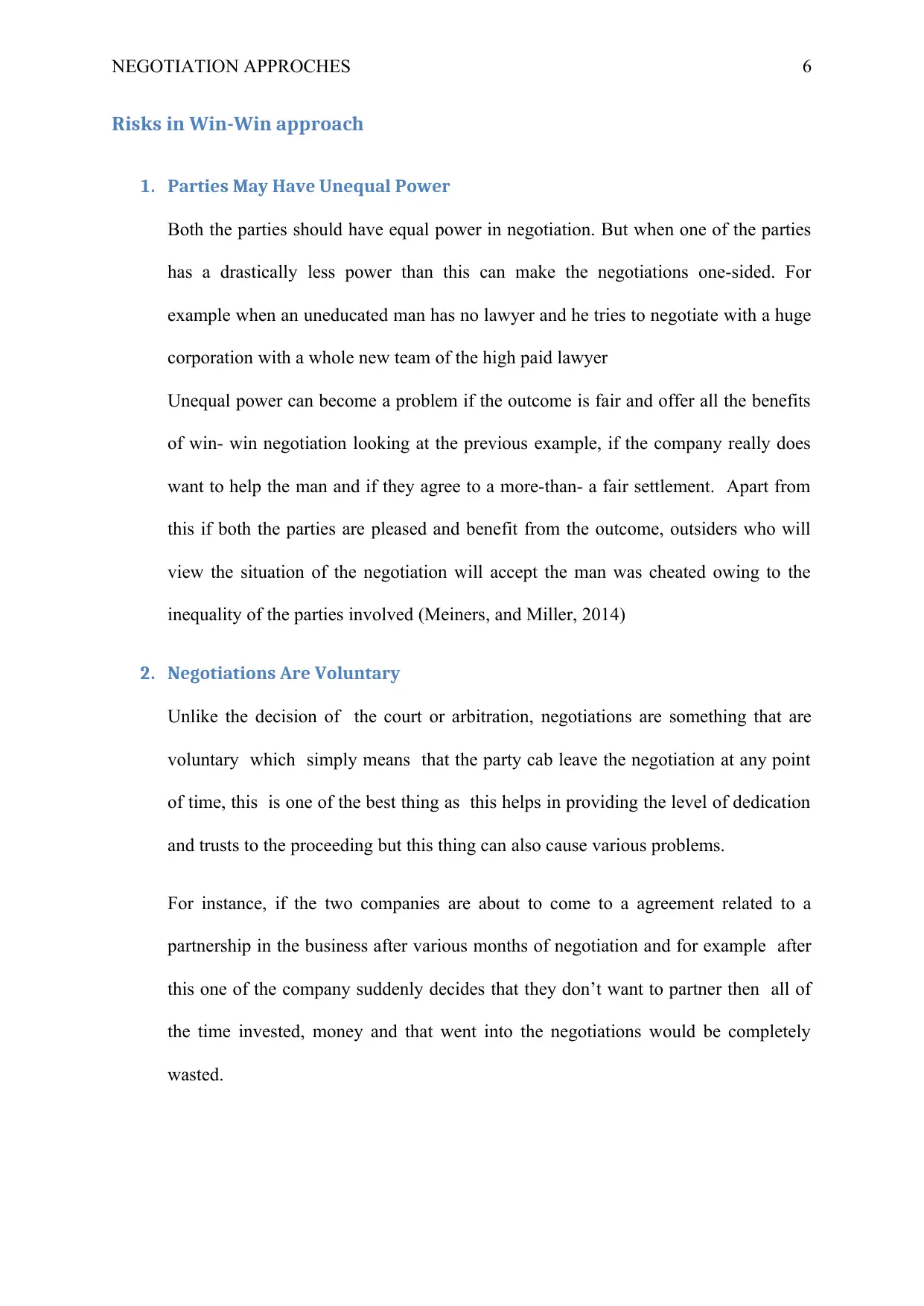
NEGOTIATION APPROCHES 6
Risks in Win-Win approach
1. Parties May Have Unequal Power
Both the parties should have equal power in negotiation. But when one of the parties
has a drastically less power than this can make the negotiations one-sided. For
example when an uneducated man has no lawyer and he tries to negotiate with a huge
corporation with a whole new team of the high paid lawyer
Unequal power can become a problem if the outcome is fair and offer all the benefits
of win- win negotiation looking at the previous example, if the company really does
want to help the man and if they agree to a more-than- a fair settlement. Apart from
this if both the parties are pleased and benefit from the outcome, outsiders who will
view the situation of the negotiation will accept the man was cheated owing to the
inequality of the parties involved (Meiners, and Miller, 2014)
2. Negotiations Are Voluntary
Unlike the decision of the court or arbitration, negotiations are something that are
voluntary which simply means that the party cab leave the negotiation at any point
of time, this is one of the best thing as this helps in providing the level of dedication
and trusts to the proceeding but this thing can also cause various problems.
For instance, if the two companies are about to come to a agreement related to a
partnership in the business after various months of negotiation and for example after
this one of the company suddenly decides that they don’t want to partner then all of
the time invested, money and that went into the negotiations would be completely
wasted.
Risks in Win-Win approach
1. Parties May Have Unequal Power
Both the parties should have equal power in negotiation. But when one of the parties
has a drastically less power than this can make the negotiations one-sided. For
example when an uneducated man has no lawyer and he tries to negotiate with a huge
corporation with a whole new team of the high paid lawyer
Unequal power can become a problem if the outcome is fair and offer all the benefits
of win- win negotiation looking at the previous example, if the company really does
want to help the man and if they agree to a more-than- a fair settlement. Apart from
this if both the parties are pleased and benefit from the outcome, outsiders who will
view the situation of the negotiation will accept the man was cheated owing to the
inequality of the parties involved (Meiners, and Miller, 2014)
2. Negotiations Are Voluntary
Unlike the decision of the court or arbitration, negotiations are something that are
voluntary which simply means that the party cab leave the negotiation at any point
of time, this is one of the best thing as this helps in providing the level of dedication
and trusts to the proceeding but this thing can also cause various problems.
For instance, if the two companies are about to come to a agreement related to a
partnership in the business after various months of negotiation and for example after
this one of the company suddenly decides that they don’t want to partner then all of
the time invested, money and that went into the negotiations would be completely
wasted.
Paraphrase This Document
Need a fresh take? Get an instant paraphrase of this document with our AI Paraphraser
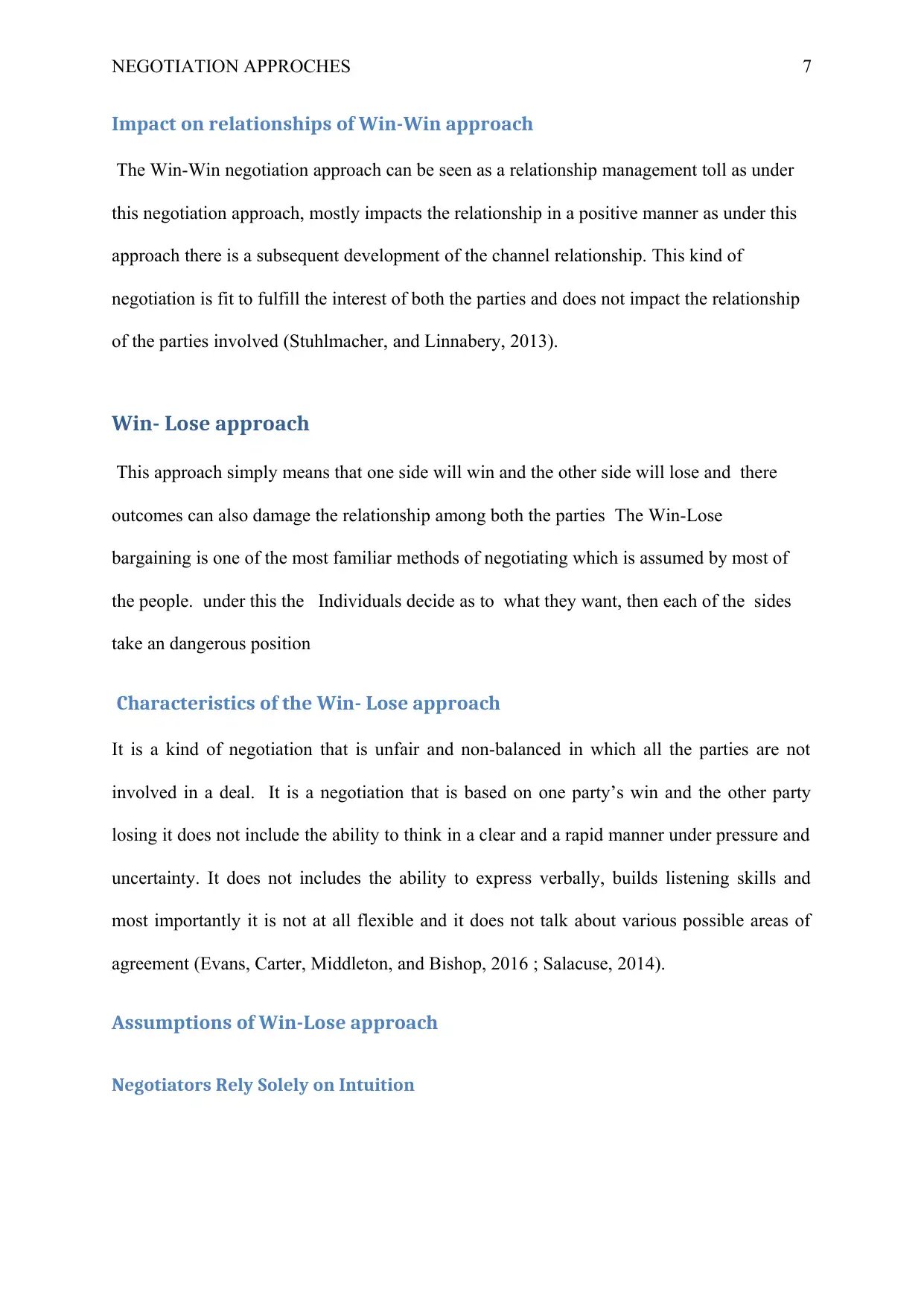
NEGOTIATION APPROCHES 7
Impact on relationships of Win-Win approach
The Win-Win negotiation approach can be seen as a relationship management toll as under
this negotiation approach, mostly impacts the relationship in a positive manner as under this
approach there is a subsequent development of the channel relationship. This kind of
negotiation is fit to fulfill the interest of both the parties and does not impact the relationship
of the parties involved (Stuhlmacher, and Linnabery, 2013).
Win- Lose approach
This approach simply means that one side will win and the other side will lose and there
outcomes can also damage the relationship among both the parties The Win-Lose
bargaining is one of the most familiar methods of negotiating which is assumed by most of
the people. under this the Individuals decide as to what they want, then each of the sides
take an dangerous position
Characteristics of the Win- Lose approach
It is a kind of negotiation that is unfair and non-balanced in which all the parties are not
involved in a deal. It is a negotiation that is based on one party’s win and the other party
losing it does not include the ability to think in a clear and a rapid manner under pressure and
uncertainty. It does not includes the ability to express verbally, builds listening skills and
most importantly it is not at all flexible and it does not talk about various possible areas of
agreement (Evans, Carter, Middleton, and Bishop, 2016 ; Salacuse, 2014).
Assumptions of Win-Lose approach
Negotiators Rely Solely on Intuition
Impact on relationships of Win-Win approach
The Win-Win negotiation approach can be seen as a relationship management toll as under
this negotiation approach, mostly impacts the relationship in a positive manner as under this
approach there is a subsequent development of the channel relationship. This kind of
negotiation is fit to fulfill the interest of both the parties and does not impact the relationship
of the parties involved (Stuhlmacher, and Linnabery, 2013).
Win- Lose approach
This approach simply means that one side will win and the other side will lose and there
outcomes can also damage the relationship among both the parties The Win-Lose
bargaining is one of the most familiar methods of negotiating which is assumed by most of
the people. under this the Individuals decide as to what they want, then each of the sides
take an dangerous position
Characteristics of the Win- Lose approach
It is a kind of negotiation that is unfair and non-balanced in which all the parties are not
involved in a deal. It is a negotiation that is based on one party’s win and the other party
losing it does not include the ability to think in a clear and a rapid manner under pressure and
uncertainty. It does not includes the ability to express verbally, builds listening skills and
most importantly it is not at all flexible and it does not talk about various possible areas of
agreement (Evans, Carter, Middleton, and Bishop, 2016 ; Salacuse, 2014).
Assumptions of Win-Lose approach
Negotiators Rely Solely on Intuition
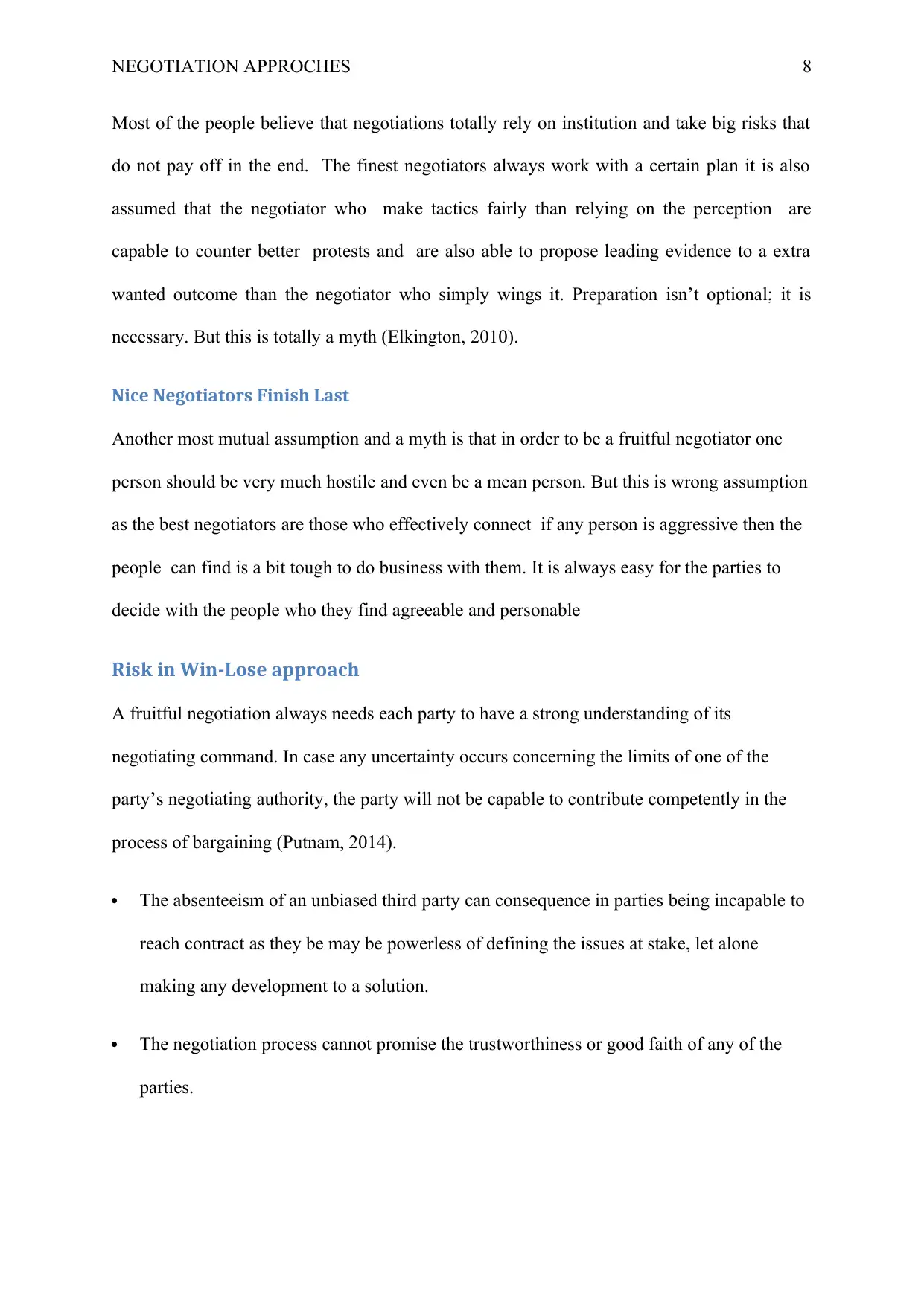
NEGOTIATION APPROCHES 8
Most of the people believe that negotiations totally rely on institution and take big risks that
do not pay off in the end. The finest negotiators always work with a certain plan it is also
assumed that the negotiator who make tactics fairly than relying on the perception are
capable to counter better protests and are also able to propose leading evidence to a extra
wanted outcome than the negotiator who simply wings it. Preparation isn’t optional; it is
necessary. But this is totally a myth (Elkington, 2010).
Nice Negotiators Finish Last
Another most mutual assumption and a myth is that in order to be a fruitful negotiator one
person should be very much hostile and even be a mean person. But this is wrong assumption
as the best negotiators are those who effectively connect if any person is aggressive then the
people can find is a bit tough to do business with them. It is always easy for the parties to
decide with the people who they find agreeable and personable
Risk in Win-Lose approach
A fruitful negotiation always needs each party to have a strong understanding of its
negotiating command. In case any uncertainty occurs concerning the limits of one of the
party’s negotiating authority, the party will not be capable to contribute competently in the
process of bargaining (Putnam, 2014).
The absenteeism of an unbiased third party can consequence in parties being incapable to
reach contract as they be may be powerless of defining the issues at stake, let alone
making any development to a solution.
The negotiation process cannot promise the trustworthiness or good faith of any of the
parties.
Most of the people believe that negotiations totally rely on institution and take big risks that
do not pay off in the end. The finest negotiators always work with a certain plan it is also
assumed that the negotiator who make tactics fairly than relying on the perception are
capable to counter better protests and are also able to propose leading evidence to a extra
wanted outcome than the negotiator who simply wings it. Preparation isn’t optional; it is
necessary. But this is totally a myth (Elkington, 2010).
Nice Negotiators Finish Last
Another most mutual assumption and a myth is that in order to be a fruitful negotiator one
person should be very much hostile and even be a mean person. But this is wrong assumption
as the best negotiators are those who effectively connect if any person is aggressive then the
people can find is a bit tough to do business with them. It is always easy for the parties to
decide with the people who they find agreeable and personable
Risk in Win-Lose approach
A fruitful negotiation always needs each party to have a strong understanding of its
negotiating command. In case any uncertainty occurs concerning the limits of one of the
party’s negotiating authority, the party will not be capable to contribute competently in the
process of bargaining (Putnam, 2014).
The absenteeism of an unbiased third party can consequence in parties being incapable to
reach contract as they be may be powerless of defining the issues at stake, let alone
making any development to a solution.
The negotiation process cannot promise the trustworthiness or good faith of any of the
parties.
⊘ This is a preview!⊘
Do you want full access?
Subscribe today to unlock all pages.

Trusted by 1+ million students worldwide
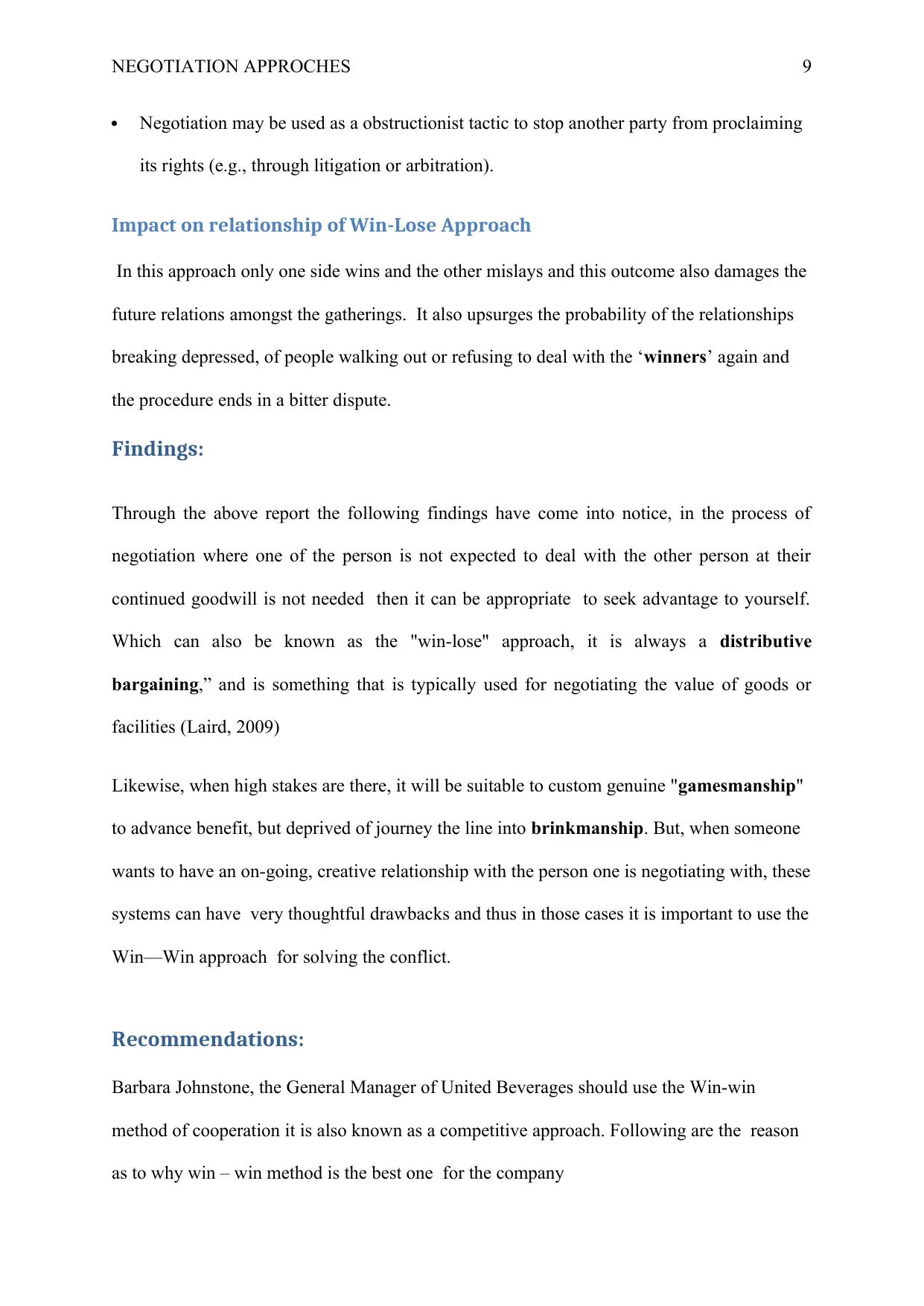
NEGOTIATION APPROCHES 9
Negotiation may be used as a obstructionist tactic to stop another party from proclaiming
its rights (e.g., through litigation or arbitration).
Impact on relationship of Win-Lose Approach
In this approach only one side wins and the other mislays and this outcome also damages the
future relations amongst the gatherings. It also upsurges the probability of the relationships
breaking depressed, of people walking out or refusing to deal with the ‘winners’ again and
the procedure ends in a bitter dispute.
Findings:
Through the above report the following findings have come into notice, in the process of
negotiation where one of the person is not expected to deal with the other person at their
continued goodwill is not needed then it can be appropriate to seek advantage to yourself.
Which can also be known as the "win-lose" approach, it is always a distributive
bargaining,” and is something that is typically used for negotiating the value of goods or
facilities (Laird, 2009)
Likewise, when high stakes are there, it will be suitable to custom genuine "gamesmanship"
to advance benefit, but deprived of journey the line into brinkmanship. But, when someone
wants to have an on-going, creative relationship with the person one is negotiating with, these
systems can have very thoughtful drawbacks and thus in those cases it is important to use the
Win—Win approach for solving the conflict.
Recommendations:
Barbara Johnstone, the General Manager of United Beverages should use the Win-win
method of cooperation it is also known as a competitive approach. Following are the reason
as to why win – win method is the best one for the company
Negotiation may be used as a obstructionist tactic to stop another party from proclaiming
its rights (e.g., through litigation or arbitration).
Impact on relationship of Win-Lose Approach
In this approach only one side wins and the other mislays and this outcome also damages the
future relations amongst the gatherings. It also upsurges the probability of the relationships
breaking depressed, of people walking out or refusing to deal with the ‘winners’ again and
the procedure ends in a bitter dispute.
Findings:
Through the above report the following findings have come into notice, in the process of
negotiation where one of the person is not expected to deal with the other person at their
continued goodwill is not needed then it can be appropriate to seek advantage to yourself.
Which can also be known as the "win-lose" approach, it is always a distributive
bargaining,” and is something that is typically used for negotiating the value of goods or
facilities (Laird, 2009)
Likewise, when high stakes are there, it will be suitable to custom genuine "gamesmanship"
to advance benefit, but deprived of journey the line into brinkmanship. But, when someone
wants to have an on-going, creative relationship with the person one is negotiating with, these
systems can have very thoughtful drawbacks and thus in those cases it is important to use the
Win—Win approach for solving the conflict.
Recommendations:
Barbara Johnstone, the General Manager of United Beverages should use the Win-win
method of cooperation it is also known as a competitive approach. Following are the reason
as to why win – win method is the best one for the company
Paraphrase This Document
Need a fresh take? Get an instant paraphrase of this document with our AI Paraphraser

NEGOTIATION APPROCHES 10
Fair-process
Unlike the other approached this is a fair approach. As when there is no fairness in the
approach the end result of the negotiation is never satisfying and helpful and thus it is best to
have a Win- Win approach in order to content the needs and wants of both the gatherings and
this also makes both the parties to feel valued and better (Lau, and May, 2010).
Joint problem-solving
Moving ahead this type of negotiation is also a very collaborative method towards
negotiation that helps in striving and converting the wants into a single issue, and carrying
both of the parties composed in order to work on resolving the problem. The theory also
states that from converting positions of an individual’s desires and wants into different
glitches, the negotiators are able to permit themselves of any personal attachment or jealously
to their necessities, in order to take a more equitable and objective position to collaborate
(Cadilhac, Asher, Benamara, and Lascarides, 2013).
Transparency and trust
While it is not be likely to give away all the info, but still there’s little broadmindedness for
misleading performs in the cooperative negotiation. Furthermore, achievement trust in such
situation is next to impossible. One of the most simple way to remove doubt is to become
transparent and open, by giving out maximum of the info (i.e. your wants, desires, end goal)
before the other party desires for it (Salacuse, 2019).
Fair-process
Unlike the other approached this is a fair approach. As when there is no fairness in the
approach the end result of the negotiation is never satisfying and helpful and thus it is best to
have a Win- Win approach in order to content the needs and wants of both the gatherings and
this also makes both the parties to feel valued and better (Lau, and May, 2010).
Joint problem-solving
Moving ahead this type of negotiation is also a very collaborative method towards
negotiation that helps in striving and converting the wants into a single issue, and carrying
both of the parties composed in order to work on resolving the problem. The theory also
states that from converting positions of an individual’s desires and wants into different
glitches, the negotiators are able to permit themselves of any personal attachment or jealously
to their necessities, in order to take a more equitable and objective position to collaborate
(Cadilhac, Asher, Benamara, and Lascarides, 2013).
Transparency and trust
While it is not be likely to give away all the info, but still there’s little broadmindedness for
misleading performs in the cooperative negotiation. Furthermore, achievement trust in such
situation is next to impossible. One of the most simple way to remove doubt is to become
transparent and open, by giving out maximum of the info (i.e. your wants, desires, end goal)
before the other party desires for it (Salacuse, 2019).
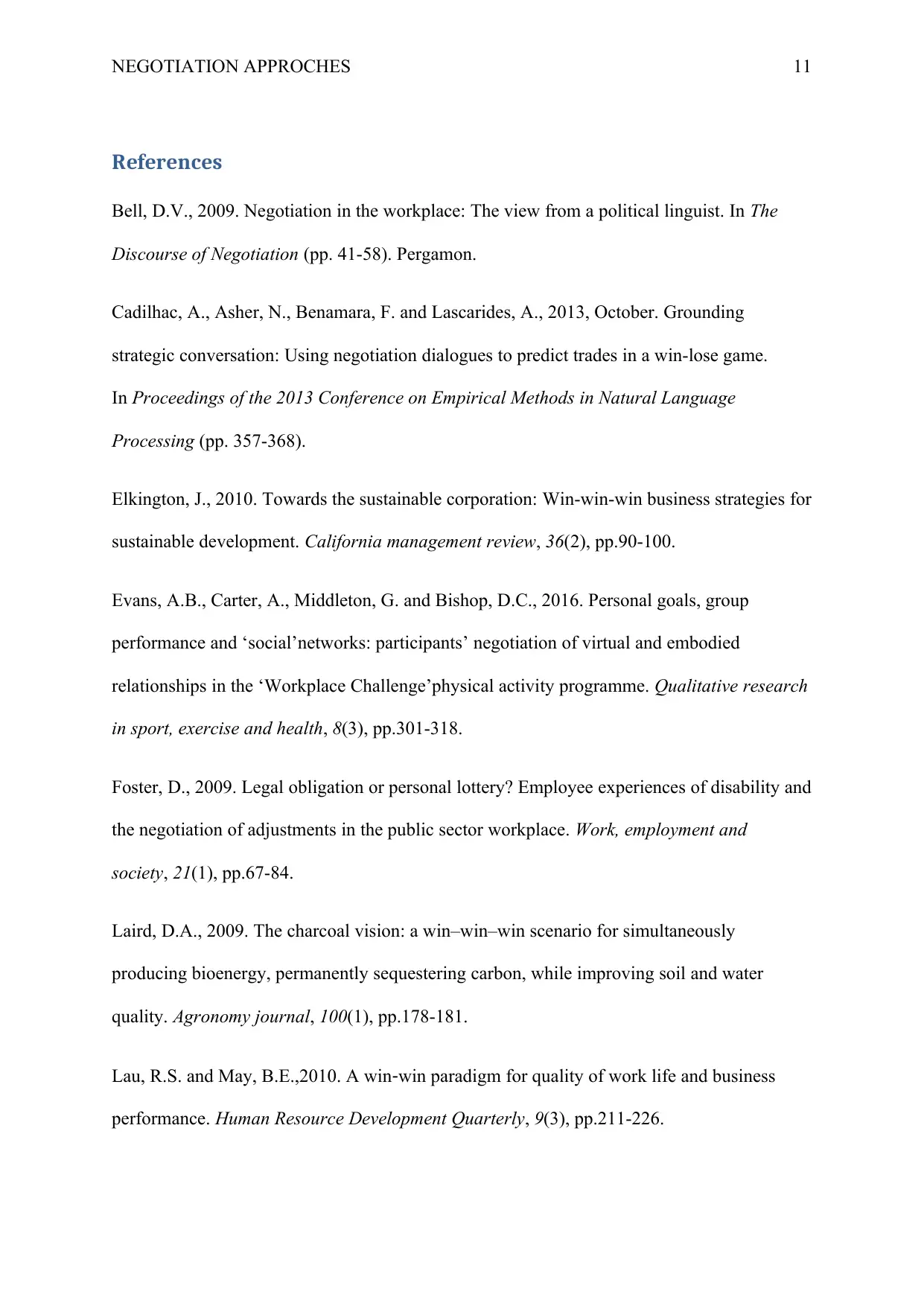
NEGOTIATION APPROCHES 11
References
Bell, D.V., 2009. Negotiation in the workplace: The view from a political linguist. In The
Discourse of Negotiation (pp. 41-58). Pergamon.
Cadilhac, A., Asher, N., Benamara, F. and Lascarides, A., 2013, October. Grounding
strategic conversation: Using negotiation dialogues to predict trades in a win-lose game.
In Proceedings of the 2013 Conference on Empirical Methods in Natural Language
Processing (pp. 357-368).
Elkington, J., 2010. Towards the sustainable corporation: Win-win-win business strategies for
sustainable development. California management review, 36(2), pp.90-100.
Evans, A.B., Carter, A., Middleton, G. and Bishop, D.C., 2016. Personal goals, group
performance and ‘social’networks: participants’ negotiation of virtual and embodied
relationships in the ‘Workplace Challenge’physical activity programme. Qualitative research
in sport, exercise and health, 8(3), pp.301-318.
Foster, D., 2009. Legal obligation or personal lottery? Employee experiences of disability and
the negotiation of adjustments in the public sector workplace. Work, employment and
society, 21(1), pp.67-84.
Laird, D.A., 2009. The charcoal vision: a win–win–win scenario for simultaneously
producing bioenergy, permanently sequestering carbon, while improving soil and water
quality. Agronomy journal, 100(1), pp.178-181.
Lau, R.S. and May, B.E.,2010. A win‐win paradigm for quality of work life and business
performance. Human Resource Development Quarterly, 9(3), pp.211-226.
References
Bell, D.V., 2009. Negotiation in the workplace: The view from a political linguist. In The
Discourse of Negotiation (pp. 41-58). Pergamon.
Cadilhac, A., Asher, N., Benamara, F. and Lascarides, A., 2013, October. Grounding
strategic conversation: Using negotiation dialogues to predict trades in a win-lose game.
In Proceedings of the 2013 Conference on Empirical Methods in Natural Language
Processing (pp. 357-368).
Elkington, J., 2010. Towards the sustainable corporation: Win-win-win business strategies for
sustainable development. California management review, 36(2), pp.90-100.
Evans, A.B., Carter, A., Middleton, G. and Bishop, D.C., 2016. Personal goals, group
performance and ‘social’networks: participants’ negotiation of virtual and embodied
relationships in the ‘Workplace Challenge’physical activity programme. Qualitative research
in sport, exercise and health, 8(3), pp.301-318.
Foster, D., 2009. Legal obligation or personal lottery? Employee experiences of disability and
the negotiation of adjustments in the public sector workplace. Work, employment and
society, 21(1), pp.67-84.
Laird, D.A., 2009. The charcoal vision: a win–win–win scenario for simultaneously
producing bioenergy, permanently sequestering carbon, while improving soil and water
quality. Agronomy journal, 100(1), pp.178-181.
Lau, R.S. and May, B.E.,2010. A win‐win paradigm for quality of work life and business
performance. Human Resource Development Quarterly, 9(3), pp.211-226.
⊘ This is a preview!⊘
Do you want full access?
Subscribe today to unlock all pages.

Trusted by 1+ million students worldwide
1 out of 13
Related Documents
Your All-in-One AI-Powered Toolkit for Academic Success.
+13062052269
info@desklib.com
Available 24*7 on WhatsApp / Email
![[object Object]](/_next/static/media/star-bottom.7253800d.svg)
Unlock your academic potential
Copyright © 2020–2025 A2Z Services. All Rights Reserved. Developed and managed by ZUCOL.



